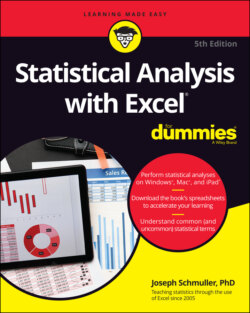Читать книгу Statistical Analysis with Excel For Dummies - Joseph Schmuller - Страница 33
Additional data analysis tool packages
ОглавлениеTwo other data analysis tool packages are available for Excel. The good news is that both work on Windows, Mac, and iPad.
One is called the XLMiner Analysis ToolPak (from Frontline Systems) and it does everything the original Toolpak does, plus an analysis called Logistic Regression. Rather than take you through this package in every chapter, I leave it until Chapter 21 when I cover Logistic Regression — and the XLMiner Analysis ToolPak provides the best way to get the job done.
I use the iPad as an opportunity to explore the other package, StatPlus (from AnalystSoft). This way, you get a deep dive into another toolset, and I don’t have to cover every combination of every platform (Windows, Mac, iPad) with every tool package (Analysis Toolpak, XLMiner ToolPak, StatPlus) in every chapter!
It turns out that the free version of StatPlus — the one I work with in this book — has some of the tools the Toolpak provides and also has some goodies the Toolpak lacks. That makes it very much worth having. Luckily for you, this add-in is easy to set up and to work with. All you have to do to add it to Excel on your iPad is tap Insert | Add-Ins | See All. In the Office Add-Ins box that appears, scroll down to StatPlus and tap Add.
When you want to use a StatPlus tool on the iPad, follow these steps:
1 Enter your data into an array.It’s a good idea to name the tab of the worksheet that contains the array.
2 Tap Insert | Add-ins | StatPlus to open the Add-ins box.If you’ve used StatPlus recently, its icon appears immediately under Recently Used Add-ins. If it doesn’t, find it in My Add-Ins. Tapping StatPlus opens the StatPlus pane on the right side of the screen.
3 In the StatPlus panel, tap New Analysis to open the Commands box.
4 Hunt down the analysis tool you want.The Commands box is organized into categories, so you might have to tap a couple of categories before you find the tool you’re looking for.
5 Tap the name of the tool.
6 Enter the values into the boxes on the StatPlus panel.From the drop-down menu for the Columns For box, select the tab where your data lives. If your spreadsheet is open to that tab, its name already appears in the Columns For box.In the Headers box, you can choose either Name in the first row or no headers.For the next few steps, keep in mind that the tool you use determines the number of Variables boxes you work with.
7 To add an array to a Variables box, select it on the spreadsheet and then tap the little three-cells-and-a-plus-sign icon for the appropriate Variables box.This step opens the Variables pane.
8 Tap Add in that pane to return to the previous pane.The selected range is in the Variables box.
9 Tap Run.StatPlus opens a new worksheet with the results.
Figure 2-29 shows the StatPlus pane after Steps 1–5 for the descriptive statistics example in the preceding section.
Figure 2-30 shows the results of the analysis. Notice that the title at the top shows the mean plus-or-minus the standard deviation.
FIGURE 2-29: The StatPlus pane, with entered values for a Descriptive Statistics analysis.
FIGURE 2-30: The results of the Descriptive Statistics analysis — compare with the results shown in Figure 2-28.
